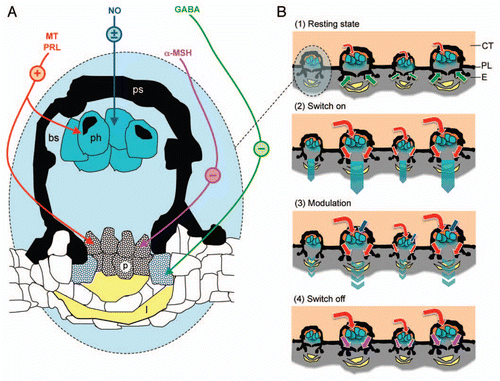Figures & data
Figure 1 Model of photophore luminescence control in the shark Etmopterus spinax. (A) Luminescence control pathways present in a photophore (transversal section). Colored arrows indicate the targets of the different substances involved in the control of E. spinax's photogenesis. Symbols in color circles indicate the effect of these substances on luminescence: +, activatory; −, inhibitory; ±, modulatory. (B) Different luminescence states in a group of photophores (transversal section): (1) resting state—photocytes are weekly stimulated to glow by low levels of circulating hormones (MT and PRL; red arrows) while GABA (green arrows) prevent light to be emitted outside the photophores by provoking pigment expansion in the pigmented cells topping the photocytes; (2) luminescence switch on—high levels of circulating hormones (MT and PRL; red arrows) stimulate the photocytes to glow and provoke pigment retraction in pigmented cells topping the photocytes, counterbalancing the effect of GABA; (3) luminescence modulation—NO (blue arrows) modulate the effects of stimulatory hormones, probably by acting directly on the photocytes; (4) luminescence switch off—α-MSH (mauve arrows) inhibits the hormonally induced light, probably by acting on the pigmented cells topping the photocytes. α-MSH, α-melanocyte stimulating hormone; bs, blood sinus; CT, connective tissue; E, epidermis; GABA, γ-amino butyric acid; l, lens cell; MT, melatonin; NO, nitric oxide; p, pigmented cell; ph, photocyte; PL, pigmented layer; PRL, prolactin; ps, pigmented sheath.

Table 1 Intrinsic pathways of substances involved in the luminescence control of Etmopterus spinax